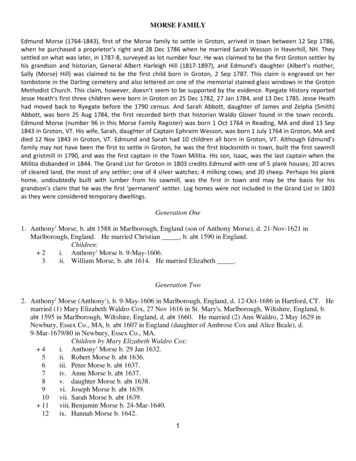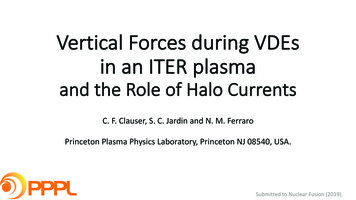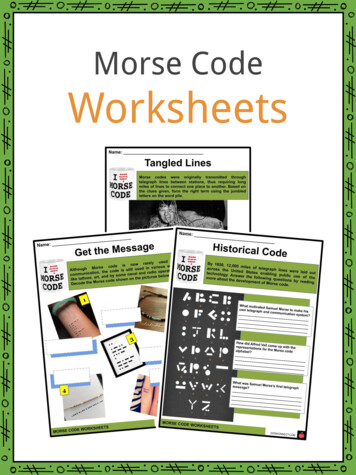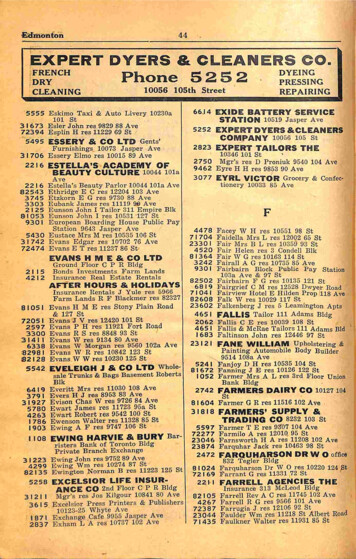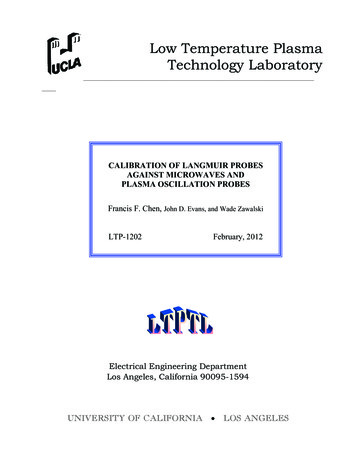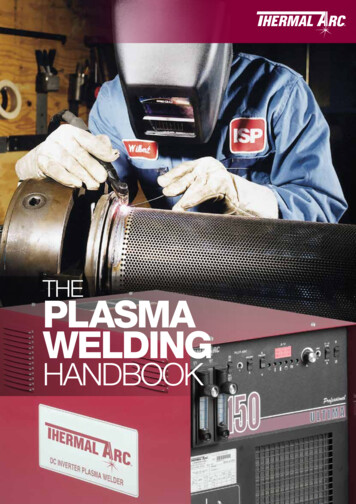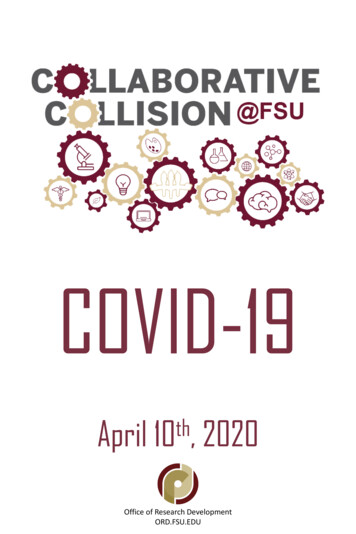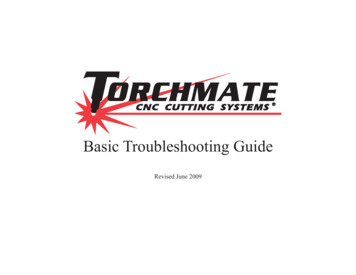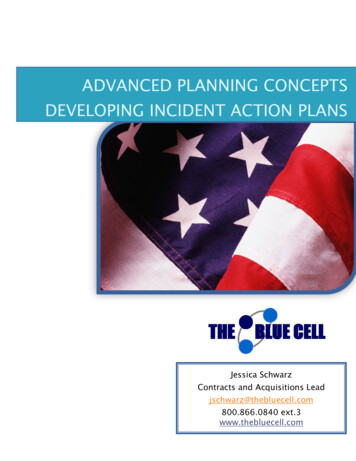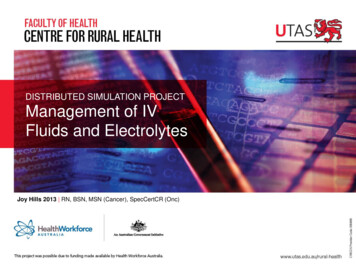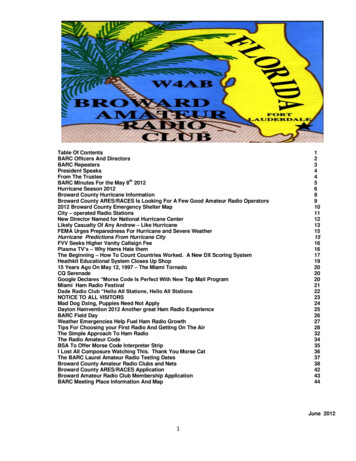
Transcription
Table Of ContentsBARC Officers And DirectorsBARC RepeatersPresident SpeaksFrom The TrusteeBARC Minutes For the May 8th 2012Hurricane Season 2012Broward County Hurricane InformationBroward County ARES/RACES Is Looking For A Few Good Amateur Radio Operators2012 Broward County Emergency Shelter MapCity – operated Radio StationsNew Director Named for National Hurricane CenterLikely Casualty Of Any Andrew – Like HurricaneFEMA Urges Preparedness For Hurricane and Severe WeatherHurricane Predictions From Hurricane CityFVV Seeks Higher Vanity Callsign FeePlasma TV’s – Why Hams Hate themThe Beginning – How To Count Countries Worked. A New DX Scoring SystemHeathkit Educational System Closes Up Shop15 Years Ago On May 12, 1997 – The Miami TornadoCQ SerenadeGoogle Declares “Morse Code Is Perfect With New Tap Mail ProgramMiami Ham Radio FestivalDade Radio Club “Hello All Stations, Hello All StationsNOTICE TO ALL VISITORSMad Dog Dxing, Puppies Need Not ApplyDayton Hamvention 2012 Another great Ham Radio ExperienceBARC Field DayWeather Emergencies Help Fuel Ham Radio GrowthTips For Choosing your First Radio And Getting On The AirThe Simple Approach To Ham RadioThe Radio Amateur CodeBSA To Offer Morse Code Interpreter StripI Lost All Composure Watching This. Thank You Morse CatThe BARC Laurel Amateur Radio Testing DatesBroward County Amateur Radio Clubs and NetsBroward County ARES/RACES ApplicationBroward Amateur Radio Club Membership ApplicationBARC Meeting Place Information And 2728323435363738424344June 20121
Broward Amateur Radio Club 2012 Club Officers & DirectorsOFFICERS & DIRECTORSNameCall SignPhone #E-mailPresidentRobin TerrillN4HHP954 249-5343n4hhp@arrl.netVice PresidentMickey BakerN4MB954 667-3553n4mb@arrl.netSecretaryKJ4FSJKJ4VAS954 566-3772rickiwitte@bellsouth.netTreasurerRicki WitteCarl Ricks954 648-4962kj4vas@gmail.comAdministrator OfficerTom HayesN4MEO954 791-9923hayesjt@bellsouth.netCommunications OfficerRob FrailingAJ4SB954 701-3966frailing@bellsouth.netBroward County EmergencyPreparedness Net ManagerMike WolfKI4JRT954 993-1256BCEPN01@gmail.comBARC Traders Net ManagerMike WolfKI4JRT954 993-1256Ki4jrt@gmail.comElectronic NewsletterRobin TerrillN4HHP954 249-5343n4hhp@arrl.netRepeater Committee & ConsultantMark LavalleeAC4UV954 961-2642mark.lavallee@advantage-com.comRepeater Committee & ConsultantMike BrandN4RQY954 961-4434n4rqy@bellsouth.netRepeater Committee & ConsultantMickey BakerN4MB954 667-3553n4mb@arrl.netRepeater Committee & ConsultantBob tRobin TerrillN4HHP954 249-5343n4hhp@arrl.netCarol SjursenKJ4AWB954 803-6338kj4awb@arrl.netARES District EmergencyCoordinatorJeff BealsWA4AW561 252-6707wa4aw@arrl.netBroward County RACES OfficerRobin TerrillN4HHP954 249-5343n4hhp@arrl.netBroward County Skywarn CoordinatorRobin TerrillN4HHP954 249-5343n4hhp@arrl.netWeb AdministratorLarry ArthurtonN4YWN615 893-7821larrya@eagle3.netCOMMITTEESARRL Volunteer Examiner LiaisonFor the Broward Amateur Radio ClubARES Emergency Coordinator2
Broward Amateur Radio Club RepeatersVHF Repeater146.910 MHz. -600 kHz, PL Tone 110.9 Hz.UHF Repeater444.825 MHz. 5 MHz, PL Tone 110.9 Hz.220 MHz, Repeater224.760 MHz -1.6 MHz. PL Tone 110.9 HzThe Broward Amateur Radio Club (BARC) was founded in 1946 and received theirARRL Charter of Affiliation March 2, 1949. The club call sign is W4AB with several repeaters covering all of but not limited to Broward County. The coverage of the repeater maybe as far South as Central Miami Dade County and as far North as PalmBeach County. In 2008, we had received our 60th anniversary award of the ARRL Affiliation.The Broward Amateur Radio Club had a member named Cy Harris, W4MAQ who envisioned a tail gate (out of the trunk of your car) type of flea market. The very first fleamarket was held in the mid 1980s’ on the Motorola NE parking lot located in SunriseFlorida. The flea market was so successful that Cy named the flea market “the FreeFlea” because there was no charge to anyone wanting to participate. The Free Fleawent on into the middle 1990s’ when Cy Harris became a silent key. In memory of CyHarris, the Broward Amateur Radio Club bestowed upon him in his name from thatpoint forward, the honor of calling the BARC Free Flea, the Cy Harris W4MAQ MemorialFree Flea.BARC Mission StatementOur mission at the Broward Amateur Radio Club (BARC) is to mentor new hams,enhance fellowship among radio amateurs, provide emergency and public servicecommunications support to the community, and further the interests of amateurradio. This shall be accomplished by providing educational programs geared towardthe new amateur radio operators and by promoting involvement in ARES /RACESfor emergency communications.3
THE PRESIDENT SPEAKSThe date of this newsletter marks the start of the 2012 Hurricane Season. You will findmaterial included in this issue that will help you to prepare yourself, your familyand your home for a possible weather disaster. We as amateur radio operatorsalso have an obligation for us holding an FCC Federal license. It’s called PUBLICSERVICE.I quote: FCC RULES AND REGULATIONS: §97.1 Basis and purpose.The rules and regulations in this Part are designed to provide an amateur radio service having a fundamentalpurpose as expressed in the following principles:(a) Recognition and enhancement of the value of the amateur service to the public as a voluntary noncommercial communication service, particularly with respect to providing emergency communications.Broward County has an active ARES/RACES program and are in need for you the amateur radio operator tostand up to the plate and make a commitment by volunteering to provide communications to the publicwhen shelters, special care facilities, hospitals, other EOCs, Utilities, Points Of Distribution (PODS), andother agencies. The Broward County Emergency Management Agency located at the Broward County Emergency Operations Center depends on radio operators to provide supplemental or total backup communications to and from the listed above. The reason they depend on us is because they know that if we get hit with acategory 3, 4 or 5 storm that the first thing that is disabled is communications.You will find a list of shelters that we cover during manmade or natural disasters that occur in our County. Ifthere are other areas that you want to volunteer for, please contact Carol Sjursen, KJ4AWB or Robin Terrill,N4HHP for more information. There phone numbers are listed on Page 2 of every Newsletter.From Our TrusteeContrary to what you might have heard, the W4AB repeater is working well. In the past year, we've installedrefurbished equipment at the North Broward and Markham Park remote receiver nodes. Coverage has been improved and the repeater is readily usable from most populated areas of Broward County with a typical mobile 2meter radio. The membership is happy to provide this repeater whenever SEFTN needs it as an alternativeto the Motorola repeater. The transmitter is located atop the 110 Tower at 410 feet in downtown Fort Lauderdale.The Florida Repeater Council requires PL on all 2 meter wide area repeaters and it is our intent to be compliantby requiring a PL of 110.9 on all of our receivers. If your PL isn't set to 110.9, you likely won't be able to accessthe repeater. Please check your PL first if you can't access the repeater.In the near future, we will be installing a controller on the central repeater that will filter the ID tones that you hearfrom multiple remote receivers. The IDs from remote nodes are required in accordance with FCC regulations.In other Broward Amateur Radio Club news, the W4AB DStar Repeater will be activated during the next fewweeks. The frequency will be 442.450, 5MHz.At any time, if you have a problem with the repeater, contact the trustee, Mickey, N4MB at n4mb@arrl.net. Hepromises help with any problems you might have accessing the repeater.Mickey Baker, N4MB4
Do you have a new idea to make the BARC better? Our Officers and Trustee want tohear what you have to say. Call or email them today! You can make a big difference.BARC April 10, 2012 Club MinutesThe program for this meeting was presented by Jim Whitehead, KK4JTW, who owns PowerExpectations, Inc. in Davie Florida. He explained the proper use and maintenance of generators during and after emergencies. Jim provided very informative information on different typesof generators which are now available and how they are installed and used.Our Treasurer, Carl, KJ4VAS reported that our Club has 3,369.62 in our checking account.Our Trustee gave a Repeater report: VHF and UHF repeaters are both doing well. D-Star repeater is ready to go to the 110Tower, but we need a server that will fit in the cabinet space. Server is on order ( 186, Dell 1850, dual power supplies,mirrored disks) for the D-Star gateway and I will re-host it this weekend.The AllStar node is established and working, node 28478 http://www.allstarlink.org. It will be moved to the primaryrepeater site during the next month.Erin Brown reported that the DCARC group will be having their own Field Day event in an undetermined location and willnot participate with BARC's Field Day.Winner of 50/50 was George Florio. Since he won two months in a row, he gave his 27.00 winnings back to the club.Members present were: N4MEO, N2DUI, KI4WFF, N4HHP, N4MB, KJ4BIG, AI4ZK, KK4JTW, AJ4VAS, AJ4ME,W3AZD, KD4FRB, N4MEO, K4EMB, N1BUZ, KK4BUH, N4FXN, KK4ITI, N2DUI, KI4WFF, KJ4EGN, K4OBS,KJ4BLW, K2HXC, KK4GUURicki Witte, KJ4FSJSecretaryMobile Radio Station For Sale. Cost Is 25,000.00 And Vehicle Is Thrown In For Nothing!5
Hurricane Season 2012From the ARRL NewsletterThe forecast for hurricane season 2012, which begins next month, is a bit more benign than past years, but thatis no reason for complacency. Prepare now!EXTENDED RANGE FORECAST OF ATLANTIC SEASONAL HURRICANE ACTIVITY AND LANDFALLSTRIKE PROBABILITY FOR 2012"We anticipate that the 2012 Atlantic basin hurricane season will have reduced activity compared with the 1981 2010 climatology. The tropical Atlantic has anomalously cooled over the past several months, and it appears thatthe chances of an El Niño event this summer and fall are relatively high. We anticipate a below-average probability for major hurricanes making landfall along the United States coastline and in the Caribbean. However,coastal residents are reminded that it only takes one hurricane making landfall to make it an active season forthem, and they need to prepare the same for every season, regardless of how much activity is predicted. (as ofApril 4, 2012)" -- Philip J. Klotzbach and William M. Gray, Department of Atmospheric Science, Colorado StateUniversity, Fort Collins, CO 80523ARES and Hurricane OperationsNow is the time for ARES members to assess their portfolio of communications equipment and disaster response knowledge. Here are several tips for amateurs involved with hurricane operations: Monitor major HF hurricane networks during events this season. The Hurricane Watch Net (HWN) on14.325 MHz is one of several key players. It serves either the Atlantic or Pacific during a watch or warning period and coordinates with the National Hurricane Center (NHC) in Miami. Frequent, detailed information is issued on nets when storms pose a threat to the US mainland. In addition to hurricane spotting,local communicators may announce that residents have evacuated from low-lying flood areas. Other amateurs across the country can help by relaying information, keeping the net frequency clear and by listening. See the HWN's website for more information. The net works closely with WX4NHC, the AmateurRadio station at the NHC.The SATERN Net (Salvation Army Team Emergency Radio Network) provides emergency communication support to the Salvation Army and populations at large. They also handle health-and-welfare traffic.SATERN holds high profile nets on 20 meters (14.265 MHz) during major hurricanes and has a long history of excellence, discipline and service. Refer to the SATERN website for more information.The Maritime Mobile Service Net (MMSN) meets on 14.300 MHz and is composed of hams who serveand assist those in need of communications on the high seas. According to its website, the primary purpose of the net is for handling traffic from maritime mobile stations. The network is recognized by theUnited States Coast Guard and has an excellent working relationship with that agency. The MMSN hashandled hundreds of incidents involving vessels in distress and medical emergencies in remote locations,as well as passing health and welfare traffic in and out of affected areas. They also work closely with theNWS and NHC by relaying weather reports from maritime stations.The VoIP SKYWARN and Hurricane Net operates by combining both the EchoLink and IRLP linked repeater networks, while handling critical wide area communications during major severe weather and tropical events. These operations have gained national stature in recent years and the net is a critical partnerwith WX4NHC. Whenever tropical weather is imposing a threat to the US mainland and certain other areas of interest, the VoIP WX net will be fully operational. See the VoIP SKYWARN and Hurricane Netwebsite for more information.6
Florida Hurricane Net on D-STARThe Florida Hurricane Net is a D-STAR net that meets each Monday night on D-STAR Reflector Ø34A at 2100EST. The primary purpose of the Net is to provide training to ARES members in the three Florida ARRL Sectionsand hurricane emergency communications in the State of Florida for served agencies if a hurricane or other disaster is threatening or strikes Florida. Although this net is focused on training and support for ARES membersand their served agencies, any Amateur Radio emcomm operator or organization is welcome and encouraged toparticipate in the net. In addition to hurricanes, the net can and will be activated by any major emergency of statewide or regional significance where it would be necessary to provide communications for and to served agenciesand/or the State Emergency Operations Center.To participate in the net, repeaters and Dongle users should connect directly to REFØ34A. D-STAR stations using their local repeater should have their radio programmed for local use with CQCQCQ in the UR field and theirlocal repeater's gateway in RPT2.The net takes check-ins using the Quick Key Format to transmit your callsign. When your Section is called, keyyour radio or Dongle for one second only when the frequency is clear. Net Control will acknowledge all check-insseen. -- Journal of the North East Florida D-STAR Repeater NetworkDuring hurricane events, there are usually two or three regional nets (usually on 40 or 20 meters) that spring toprominence as major key assets to the disaster response on an ad hoc basis. Watch for these nets, as well asthe nationally recognized networks described above, this season. Don't transmit on their frequencies unless youare absolutely sure you have something substantive to add, and then only under the direction of the net controlstation.ARRL Emergency Preparedness Manager Mike Corey, KI1U, adds that when ARES activates in response toany tropical event, it is crucial that information flows up through the Section and is reported to Headquarters."These reports allow us to develop the situational awareness and disaster intelligence that is required for us asan organization to support the Sections that are impacted," he explained. "In this way, we are able to respond torelevant requests from the media and finally to coordinate with the governmental and non-governmental organizations. This information also allows us to make the decision at Headquarters on whether to stand up the ARRLHQ Emergency Response Team to support and coordinate the operations."7
Broward County Hurricane InformationHurricane season is June 1 through November 30. A typical season is most active from August through October. Hurricanes are divided into five categories, from Category 1, which produces the least damage, toCategory 5, which causes the most devastating damage.Category 1Sustained winds 74-95 mph, 64-82 kt, or 119-153 km/hr Damage primarily to shrubbery, trees, and unanchored mobile homes. No real damage to otherstructures.Some damage to poorly constructed signs.Older (mainly pre-1994 construction) mobile homes could be destroyed, especially if they are notanchored properly.Windows in high- rise buildings can be broken by flying debris.Category 2Sustained winds 96-110 mph, 83-95 kt, or 154-177 km/hr Considerable damage to shrubbery and tree foliage; some trees blown down.Major damage to exposed mobile homes. Extensive damage to poorly constructed signs; some damage to roofing materials of buildings; and some window and door damage. No major damage tobuildings.Considerable damage to piers. Marinas flooded and small craft in unprotected anchorages torn fromtheir moorings.There is a substantial risk of injury or death to people, livestock, and pets due to flying and fallingdebris.Category 3Sustained winds 111-130 mph, 96-113 kt, or 178-209 km/hr Foliage torn from trees; large trees blown down.Practically all poorly-constructed signs blown down; some damage to roofing materials of buildings;some window and door damage; structural damage to small buildings.Mobile homes destroyed.Electricity and water will be unavailable for several days to a few weeks after the storm passes.Most commercial signage, fences, and canopies will be destroyed.Category 4Sustained winds 131-155 mph, 114-135 kt, or 210-249 km/hr Shrubs and trees blown down; all signs down.Extensive damage to roofing materials, windows and doors; complete failure of roofs on many smallresidences.Complete destruction of mobile homes.Large amounts of windborne debris will be lofted into the air. Windborne debris damage will breakmost unprotected windows and penetrate some protected windows.8
Category 5Sustained winds greater than 155 mph, greater than 135 kt, or greater than 249 km/hr Shrubs and trees blown down; considerable damage to roofs of buildings; all signs down.Very severe and extensive damage to windows and doors; complete failure of roofs on many residences and industrial buildings; extensive shattering of glass in windows and doors; some completebuilding failures.Small buildings overturned or blown away.Complete destruction of mobile homes.Hurricane NamesThe following names have been selected for the 2012 Atlantic Hurricane Season:1.2.3.4.5.6.7.8.9.Alberto (al-BAIR-toe)Beryl (BER-ril)Chris (kris)Debby (DEH-bee)Ernesto (er-NES-toh)Florence (FLOOR-ence)Gordon (GOR-duhn)Helene (heh-LEEN)Isaac (EYE-zik)10.11.12.13.14.15.16.17.18.Joyce (joyss)Kirk (kurk)Leslie (LEHZ-lee)Michael (MY-kuhl)Nadine (nay-DEEN)Oscar (AHS-kur)Patty (PAT-ee)Rafael (rah-fah--ELL)Sandy (SAN-dee)19. Tony (TOH-nee)20. Valerie (VAH-lur-ee)21. William (WILL-yum)Updated March 2012Broward County ARES / RACES Is Looking For A Few Good Amateur Radio OperatorsEvery year, the Broward County ARES / RACES are tasked toprovide backup communications to the Shelters listed on the nextpage. We are also asked to provide backup communications tothe North Broward Hospital District along with other hospitals, citypolice, fire, utilities etc. throughout Broward County.As with every year here in Florida, both the ARES / RACES organization reach out to the old and new amateur community herein Broward County soliciting ham radio operators to volunteertheir communications skills when either man-made or natural disasters occur.Please evaluate your own situation and if you feel that you can take on an assignment, look at the list on the next page andthen please contact Carol Sjursen, KJ4AWB, the Broward County ARRL Emergency Coordinator at 954 803-6338 or emailher at kj4awb@arrl.net or contact Robin Terrill, N4HHP, the Broward County RACES Officer at 954 249-5343 or email himat n4hhp@arrl.net. Please see if there is a shelter near where you live and make yourself known that you want to step up tothe plate and volunteer to be that communicator for that certain facility.Honestly, we need commitments from you now to make sure that we can cover the facilities when the need arises.We are looking for amateur radio operators both old timers and newcomers to the hobby alike. Remember that you arethe only means of communications during and after an event as all other modes of communications will be overloaded orcompletely non-existent.In the back of this Newsletter, you will find a ARES/RACES Application. Please fill it out and bring it to a meeting.Location and Directions and times of the meetings are on the last page. .9
10
City-Operated Radio StationsCORAL SPRINGSWQFL 1670 AMProgramming: Community information, events,educational campaigns, and emergency information.OAKLAND PARKWQEI 1680 AMProgramming: Emergency alert radio with liveweather updates and city emergency bulletins andinformation.FORT LAUDERDALEWPZK 1610 AMProgramming: Emergency announcements, safetyalerts, notifications on city services, supply distributions, etc.PEMBROKE PINESWQFU 1670 AMProgramming: Broadcasting the latest informationfollowing a hurricane or other emergency situation.HALLANDALE BEACHWQFQ 1620 AMProgramming: Weather form NOAA, notification ofcitywide events, programs and public safety information.PLANTATIONWQFL 1620 AMProgramming: City events, news, traffic and roadclosings, and emergency notifications.SUNRISEWPDA 1610 AMProgramming: Information on city departments,events, roadway and traffic information, and otheritems including safety tips and community education.HOLLYWOODWQFL 1630 AMProgramming: Updates on hurricane informationand city events.LAUDERHILLWQFF 1650 AMProgramming: National Weather Service Weatheralerts, emergency information and citywide announcements.WESTONWPUV 1680 AMProgramming: Information on city departments,events, roadway and traffic information, and otheritems including safety tips and community education.MIRAMARWQCA 1280 AMProgramming: Information on city services, programs, events, traffic and weather forecasting.WILTON MANORSWQHF 1630 AMProgramming: Weather from the National WeatherService and city emergency information.TV-Radio Station SimulcastsWSVN – Ch. 7 – Fox NetworkHot 105 (FM)99 Jam (FM)97.7 Coast (FM)93 Rock (FM)KISS – 99.9 (FM)WQAM 560 (AM)WLRN 91.3 (FM)WBFS – Ch. 33 – UPN NetworkSee WFOR-TV – Ch. 4 listing above.WPLG – Ch. 10 – ABC NetworkSouth Florida Classical 89.7 (FM)WLRN – Ch. 2 – Public BroadcastingSee WFOR-TV – Ch. 4 listing above.WFOR – Ch. 4 – CBS NetworkWBFS-TV – Ch. 33WIOD – 610 (AM)WINZ – 940 (AM)WLRN-TV – Ch. 2Univision TelevisionAmor 107.5 FMLa Kalle 98.3 FMWQBA 1140 AMRadio Mambi 710 AMWTVJ – Ch. 6 – NBC NetworkPower 96.5 (FM)11
New director named forNational Hurricane CenterThe 2011 Atlantic hurricane season was the sixth consecutive year without the U.S. landfall of a major hurricane. Those are storms classified as Category 3 or higher, with top winds of at least 111 mph. The National Oceanic and Atmospheric Administration is set to release itshurricane season outlook next week.BY JENNIFER KAY ASSOCIATED PRESS / MIAMI HERALDMIAMI -- Richard Knabb, thetropical weather expert atThe Weather Channel, willbe the next chief of the U.S.government's hurricane forecasting hub in Florida, federal officials said Friday . The promotion to director of theNational Hurricane Center in Miami fulfills a childhooddream for Knabb, who grew up in Coral Springs and laterwas a forecaster at the center. Knabb remembers watching the hurricane center's director on local television newsas Hurricane David aimed at Miami in 1979. The stormeventually swerved and made landfall farther north inPalm Beach County, but Knabb was hooked on the tropical storm forecasts."At the helm, (the center's) director must be the cool andcalm voice that conveys this array of information thatprompts life-saving actions from an individual across alllevels of emergency management and even internationally, and I firmly believe that our next director embodies thisreputation," said NOAA Administrator Jane Lubchenco.After leaving the hurricane center, Knabb served as thedeputy director of the Central Pacific Hurricane Center inHonolulu. He joined The Weather Channel in 2010.Knabb will replace Bill Read, who steps down as directorJune 1, the official start of the six-month Atlantic hurricane season.Other hurricane specialists who work outside the NationalHurricane Center applauded the selection of Knabb forone of the toughest jobs in weather forecasting."Largely that came out of personal, childhood fear. Iwanted to be able to figure out how to forecast thosethings myself because they posed such a danger to folksin hurricane-prone areas," said Knabb, 43. "From thatpoint forward I think I knew that that was what I was goingto end up doing as a career."Knabb is well qualified for the job, said Kerry Emanuel, anMIT meteorology professor who specializes in hurricanes."That job requires a terrific amount of energy and enthusiasm. It tends to burn people out. It's good to choose ayoung person who has a lot of energy and experience,"Emanuel said.Knabb started working at the hurricane center in 2001. Hewas a senior hurricane specialist at the center from 2005to 2008, experiencing what other longtime forecasterscalled "decades of hurricane activity in just a few years,"thanks to the overactive and devastating 2004 and 2005seasons.Knabb not only has the scientific credentials to lead thehurricane center, he also understands the importance ofthe job's communications aspect, said Heidi Cullen, aclimatologist at the nonprofit Climate Central in New Jersey and a former climate expert for The Weather Channel."I was living the hurricane problem while I was helpingothers prepare for the hurricane problem," Knabb said.Knabb is already cautioning coastal residents to be prepared."This is someone who is incredibly experienced andknows how to handle the really, really intense situation ofbroadcasting during hurricane landfall," said Cullen, adding "you want someone who is not going to overhype asituation and really can communicate the risks and uncertainties.""One of these days another major hurricane is going tocome to the U.S., and we need to be prepared. And thatstarts with me and my family," Knabb said. "We're goingto be living in South Florida again, and we have to have ahurricane preparedness plan for our home and our family.And that will be just one of the examples I'll try to set forpersonal preparedness."AP Science Writer Seth Borenstein contributed to thisreport from Washington HURRICANE SEASON12
Likely casualty of anyAndrew-like hurricane:cell phonesridians whose only contact with the outside world was thesound of his steadying voice.Back then, Norcross’ station (WTVJ-Channel 4) was oneof just a few places to go for real-time hurricane information — something unimaginable to the SmartphoneGeneration, which has an app for most everything, severeweather alerts included.Sent in by Al / kd4knvIn today’s world of iPhones and social media, the next bighurricane could leave some of us worse off than we wereafter Andrew.But with the official start of the hurricane season Friday —the 20th since Andrew killed dozens and causes billionsin damage across South Florida — Norcross’ voice hasturned from soothing to concerned.His worry: When your primary source of information isyour iPhone, what happens when the power is out andthere is no place to recharge it? And even if you do havejuice, what if the network is down?“If you had a hurricane like Andrew hit now, [the cellularinfrastructure] just wouldn’t work,” said Norcross, now ahurricane specialist for the Weather Channel. “It’s a monstrous public-safety issue that more and more of theemergency communication industry is electricity- andbandwidth-dependent.”Dr. Gerry Bell, lead seasonal hurricane forecaster at NOAA Climate Prediction Center, discusses the upcoming hurricane season after a press conference in Miami, Thursday, May 24, 2012.U.S. forecasters predict there will be about nine to 15 stormsduring this year's Atlantic hurricane season.In the days after Andrew struck, people kept informed viatransistor radio, landline telephone — and the newspaper,whose trucks continued to navigate through the wreckage. The paper served as sort of a printed precursor totoday’s social media, listing who was unaccounted for,how to locate ice and water, and where the damage wasworst. Phone service was spotty, and the power was outfor days or weeks, depending on the neighborhood. People from out of town with relatives in South Floridacouldn’t necessarily reach them to find out if all was well.J PAT CARTER / AP Related ContentHurricane season off to a fast startComplete coverage of 2012 Hurricane SeasonHOW TO STAY IN THE LOOP Buy an AM/FM transistor radio and keep plenty of batteriesToday, transistor radios and landline phones are increasingly rare. And the manner in which most people receiveand relay information (mobile gadgets and broadbandbased house phones, neither of which work for long without a power supply) is even more susceptible to the elements. Keep your mobile device charged at all times, and own a carcharger Sign up for emergency text alerts at MiamiDade.gov orBroward.org Establish a family communications planWhen Hurricane Katrina lashed the Gulf Coast in 2005,the storm knocked out more than three million customerphone lines and over a thousand cellphone sites, according to the Government Accounting Office.BY ADAM H. BEASLEYABEASLEY@MIAMIHERALD.COMFamed weatherman Bryan Norcross made his broadcasting bones when Hurricane Andrew was at its worst, remaining on the air for 23 hellish hours to provide stormupdates and to counsel scared and stranded South Flo-It’s strange to think it now, but even that was a differentera. The do-it-all iPhone was more th
BARC Officers And Directors 2 BARC Repeaters 3 President Speaks 4 From The Trustee 4 BARC Minutes For the . Broward County Skywarn Coordinator Robin Terrill N4HHP 954 249-5343 n4hhp@arrl.net Web Administrator Larry Arthurton N4YWN 615 893-7821 larrya@eagle3.net. 3
